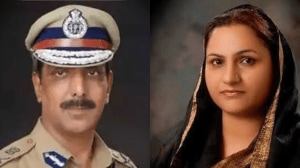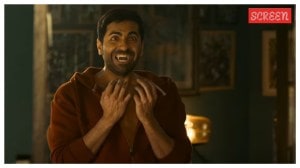Of cuts, action and families ties
As an army man, if there was one word that Lieutenant General Y.D. Sahasrabuddhe (retd.) had been accustomed to all his life, it was `action...

As an army man, if there was one word that Lieutenant General Y.D. Sahasrabuddhe (retd.) had been accustomed to all his life, it was `action’. Nevertheless, when he heard it being bellowed out at the Bhandarkar Oriental Research Institute last fortnight, he found himself having trouble identifying with it. For unlike his days in the forces, `action’ here had nothing to do with guns and grenades and everything to do with lights and camera.
This was courtesy his guest appearance in Amol and Chitra Palekar’s Kal Ka Aadmi, the film on R.D. Karve, the social reformer and pioneer of modern family planning methods back in the first quarter of the 20th century, to whom Sahasrabuddhe happens to be closely related. Little had the retired general realised that when the Palekars came to him for some background material on Karve, it would ultimately lead to his wife Manik and him facing the arc lights themselves – a memorable `first’ for the two.
“About four months ago, we got the message that Amol and Chitra Palekar were making a film on R.D. Karve,” recounts Sahasrabuddhe. With Karve’s wife being his aunt (his mother’s sister), it was not too surprising when he received a call two months later, intimating that the Palekars wanted to meet the two for hour an hour. “They dropped in one evening and instead of 30 minutes, stayed for over two and a half hours. Basically, they wanted to know what kind of person Karve was. When I was 10, I had stayed with the Karves in Mumbai and was thus able to describe my uncle quite accurately – a brilliant though aloof man, suffused with the aim of bringing about birth control awareness amongst the populace. During my description, Chitra suddenly jumped up, came up to me and shook my hand. She said that my description matched to perfection the picture of Karve she had in mind”.
Thus gratified, the Palekars took their leave, informing the Sahasrabuddhes of their plans to launch the film on October 14 – the birth anniversary of Karve – in Pune. “They kept the date but apparently launched it in Mumbai. On October 24, we received a call from Amol Palekar stating that they were in Pune to begin shooting for the film. And to our surprise, he wanted my wife and me to be part of the film. Amazed, I immediately replied that neither of us had much acting experience. Palekar explained that we would not be required to deliver any dialogues and would just be part of the scene depicting Maharshi Karve’s (father of R.D. Karve) second marriage, where we would be amongst the guests”.
While the general was in two minds about the appearance, sentiments and his son and daughter-in-law’s persuasion led him to accede to the request. Thus the morning of October 26 found Manik and him on the sets of Kal Ka Aadmi.
“After agreeing to be in the scene, we had gone to meet the Palekars at their hotel the next day. While we were chatting, Amol suddenly suggested that he and I take a walk down the lane. To my horror, he led me to a hair-cutting saloon!” exclaims Sahasrabuddhe. It was with a distinct feeling of deja vu that this former general slipped into the high chair. For the last time he had probably squirmed at the barber’s was in 1946, when as a first-term cadet, he had surrendered himself to a pair of scissors at the National Defence Academy for the mandatory crop. “Amol informed me that I would be required to wear a pagote and no hair should be seen sticking out from under it. Thus the lower hair was clipped off”.
“Earlier, I was supposed to wear a dhoti, kurta with the long black coat, but was not too comfortable with the attire. Fortunately, designer Bhanu Athaiya, changed her mind last minute and asked me to get along my suits. She chose a brown one and supplemented it with a brown waistcoat and an old-fashioned tie.”
For Manik, a white sari was provided. “When a still from the shoot was published a few days back, my friends commented that it was too simple an attire for a wedding. But I was supposed to be accompanying Pandita Ramabai, who was also wearing a white sari… My hairstyle, too, was changed – I had a middle parting as was the custom in 1894,” she adds.
Another not-so-convenient addition for the general was a moustache. “The make-up man fixed one in the morning but after an hour, realised that it looked too Punjabi. So it was changed for another one that, it seems, was more Maharashtrian-looking,” smiles Sahasrabuddhe. On the flip side, this moustache prevented him from moving his upper lip. Thus, every time the general felt like a drink or a bite, the moustache had to be taken off and pasted back again.
The real filmi experience, however, came from the fact that while the Sahsrabuddhes were ready for shooting by 10.30 a.m. as required, the shooting actually began at 4.30 p.m.! Quite a shock for the typically-disciplined army man.
But despite this chaos and confusion, what has really left a lasting impression on the Sahasrabuddhes was the amount of work, precision and technical skill they witnessed behind every single shot. And also the concern. “When Atul Kulkarni, the man who played Gopal Ganesh Agarkar, had a bout of shivering, Amol immediately stopped shooting and sent everyone scurrying for blankets and a warm drink. He was then taken special care of for the rest of the shoot,” remembers Manik.
“The two-day shooting made us realise that film-making is serious business, and we grew quite close to the unit,” she concludes. She intends to preserve the pictures sent to them by the Palekars to show to her grandchildren.



- 01
- 02
- 03
- 04
- 05




























